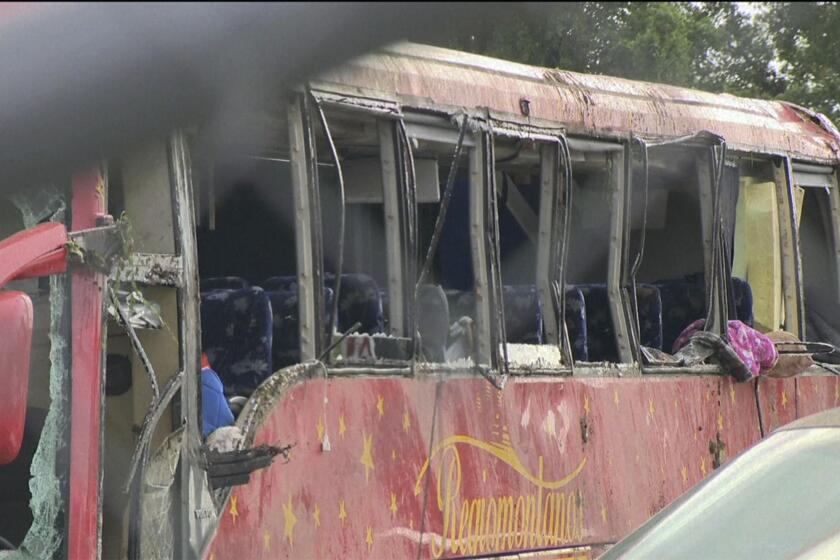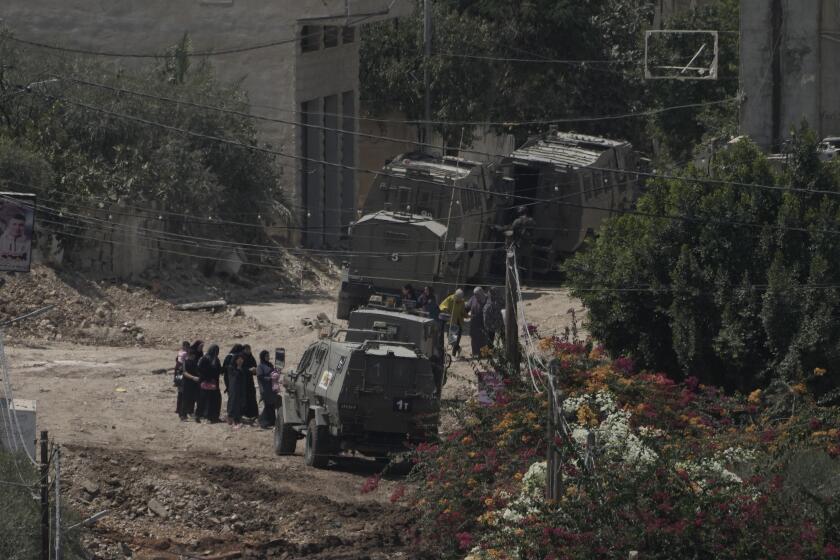COLUMN ONE : Boning Up on Iraq’s Way of War : U.S. military seeks clues to Hussein’s next move by studying strategies used against Iran. By identifying strengths and failings, they hope to learn from Tehran’s mistakes.
During a fight near Susangerd, they purposely bowed their lines, lured an enemy tank division into the trap and then slaughtered it.
At the battle of Fish Lake, they sent high-voltage currents surging through the water to electrocute enemy infantrymen fording the marshy shallows.
In retaking the port city of Al Faw, they caught the enemy off guard with an artillery barrage launched on a holy day, followed by an assault involving nearly 200,000 troops supported by helicopter gunships.
For eight years, from 1980 to 1988, Iraq waged savage war with Iran, ultimately winning it with stolid tactics and at times deadly innovation. By CIA estimates, no fewer than 550,000 Iraqis and 1 million Iranians were killed or wounded.
It was a war closed to all but a few outsiders, usually relegated to the back pages of most newspapers in the United States. Not even Soldier of Fortune magazine, whose stock in trade is luridly detailed combat journalism, was ever able to chronicle the butchery. “No one,” associate editor Tom Slizewski conceded, “wanted to go.”
In recent months, however, U.S. military analysts have pored over every available snippet of intelligence on Iraq’s long war with Iran, looking for strengths and tactics to be countered and weaknesses to be exploited in the Persian Gulf conflict.
“The first lesson,” said Anthony Cordesman, a U.S. Senate military aide who has co-authored three books on the Iran-Iraq War, “is that you cannot count on this force (Iraq’s) to break. . . .”
The Iraqis were, first and foremost, superb defensive fighters, especially when fighting on their own soil, Cordesman has written. Their officers planned campaigns with increasing skill over the course of the war and sought to minimize casualties. Except for poorly trained militia units, their foot soldiers generally showed grit under fire.
In contrast to Western armies, which commonly use reinforcements only to solidify battlefield success or launch counterattacks, the Iraqis frequently threw their reserves into action to salvage deteriorating engagements or deliver death blows to enemy units that had been trapped in predesignated “killing zones.” And when the Iraqis attacked, they usually deployed their million-man army in staggering numbers to overwhelm rather than outmaneuver the enemy.
At the same time, Iraq’s rigid, centralized chain of command often proved plodding when the pace of fighting suddenly shifted or the direction of battle did not go as planned.
Like the Soviets who trained them, Iraqi field commanders tended to rely on directions from superiors who were often miles away before responding in force to unexpected battlefield developments. This inability to think on their feet proved fatal for many of their troops.
“When things don’t go their way,” said retired Gen. Edward C. Meyer, former U.S. Army chief of staff, “they tend to screw up badly.”
Against the Iranians, Iraqi field commanders frequently had difficulty coordinating air, ground and naval forces. Their fighter pilots showed little verve in combat. Ground gunners expended inordinate ammunition without hitting their targets.
According to some experts, Saddam Hussein’s forces have already exhibited some of these same tactics and failings in the Gulf War.
For instance, they point to the engagement last week at the deserted Saudi border town of Khafji, where an advancing Iraqi armored brigade was beaten back after sustaining considerable losses. In their war with Iran, the Iraqis frequently launched such limited, or “spoiling,” attacks to provoke the Iranians into prematurely charging well-defended positions.
American commanders resisted any such temptation, saying they will not simply throw men and machines at dug-in Iraqis, as Tehran did repeatedly and at great cost. Instead, their plans call for coalition ground forces to remain fluid and lightning quick, outmaneuvering Hussein’s army, confusing it with electronic wizardry and overwhelming it with air power--weapons and tactics the Iraqis saw little of when fighting Iran.
There are great differences between Iran’s poorly trained, ill-equipped forces and the modern, massive allied forces in the Gulf. The contrast is so great that some experts suggest there isn’t much to be gained from studying the Iran-Iraq War.
“They have never experienced fast, high-tech, ‘maneuver’ warfare,” said Meyer, the retired Army chief of staff, “and that’s what we’re going to give them.”
Still, analysts agree that Iraq’s war with Iran may offer considerable insight into how Hussein’s troops will fight should a full-scale land war commence.
The seeds of war were sown in 1975, when Iraq handed over to the Shah of Iran half of the rights to the Shatt al Arab waterway that separates the two countries and leads into the northern waters of the Persian Gulf. The shah, in exchange, vowed to cut off his support of Kurdish separatists in northeast Iraq.
But after the shah was overthrown in January, 1979, Iran’s Ayatollah Ruhollah Khomeini renewed support of the Kurds. Hussein gained the presidency of Iraq six months later and, in retaliation, threatened to grab back all of the Shatt al Arab.
He made good on the threat on Sept. 22, 1980, when thousands of Iraqi troops stormed across the waterway and 20 miles into Iran. Tehran’s forces slowly fell back, regrouped as winter set in, then counterattacked in the spring, throwing back the Iraqis and capturing tens of thousands of prisoners.
For the next seven years, war ebbed and flowed along a meandering, 730-mile-long, no-man’s-land of elaborate fortifications, razor wire and explosive mines. The entrenched Iraqis lobbed poisonous chemical weapons at the Iranians, bombarded them with massive artillery barrages and repelled repeated “human wave” assaults by fanatic Iranian teen-agers.
As the Iranians were ground up in their suicidal charges, Hussein husbanded his forces and waited.
Finally, in April, 1988, Iraqi troops and tanks launched a furious blitzkrieg that, within five months, had virtually destroyed Iran’s army, forced Khomeini to a truce and elevated Iraq to the status of a menacing, regional superpower. In the assault, Iraq’s helicopter tactics were so sophisticated that Iranian leaders accused the United States of helping coordinate them.
Iraq’s military emerged from the conflict five times greater in size and full of confidence, the U.S. Army War College concluded in a report, “Lessons Learned: The Iran-Iraq War,” made public just days before the U.S.-led aerial bombardment of Iraq began on Jan. 17.
Co-authors Douglas V. Johnson and Stephen C. Pelletier contend that Iraqi fighting men have come to see themselves as the beneficiaries of an ancient warrior tradition. It was, after all, primarily the Iraqis who spread Islam throughout much of the Middle East in the 7th Century.
“As long as Saddam does nothing to impair the dignity of the army,” the report states, “(his officers) will back him to the hilt. . . . The army has high institutional self-esteem. Morale is good after the victory over Iran.”
At the outset of the Iran-Iraq War, Hussein’s men lacked the sophistication to take full advantage of many of the modern weapons systems they possessed, Cordesman found in his research.
There was inflexible planning and direction. Iraqi pilots, for example, would make repeated attempts to crater enemy runways while ignoring the unprotected aircraft parked next to them.
There was little coordination between Iraq’s military services, leaving the air force generally unable to provide close air support to army units, and widespread waste of ammunition. Iraqi gunners would blast away at targets, often firing more artillery rounds in a day than their U.S. counterparts would normally expend in a week.
Iraqi militiamen--the non-professional soldiers who augmented Hussein’s regulars--were susceptible to mass panic, fleeing when ordered to hold their positions against screaming Iranian skirmishers.
“They swarm at you like roaches,” a horrified Iraqi commander was quoted as saying after one such nighttime attack.
But the Iraqis are among the most educated people in the Middle East, with a literacy rate of 70%--superior to Saudi Arabia (50%), Iran (48%) and Egypt (44%). As fighting progressed, by all indications, they swiftly became proficient in the ways of war.
Throughout the conflict, Hussein purged political hacks from his army, handing over operational control to professional officers who were rewarded with promotions, homes and even Mercedes-Benzes for accomplishments in battle. Many of those who suffered gross failures under fire were later executed alongside deserters.
Artillery crews were trained carefully in “target acquisition”--the process of precisely pinpointing a target before firing at it.
The number of Iraq’s vaunted Republican Guard brigades, meanwhile, was expanded. Generals made more effective use of their helicopter pilots--the “brave knights” as Hussein describes them--in support of ground troops.
The Iraqis ultimately were victorious because they “planned for and successfully executed complicated, large-scale operations and shrewdly managed their resources,” says another report prepared in 1990 by the U.S. Army War College.
In a major battle near the Iranian border town of Susangerd in January, 1981, the Iraqis tricked an advancing Iranian armored division into believing that it was pushing through the lines. The Iraqis then closed flanks and counterattacked from two sides, destroying more than 200 tanks. It was the same tactic Hannibal employed with equal success against the Romans at Cannae two centuries before Christ.
At Fish Lake, a battle also fought on the Iranian border for nearly three weeks in January, 1987, the Iraqis demonstrated that they could wage a complex and mobile campaign, concentrating their fire in zones in which Iranian infantry were massed, cutting them down by the hundreds. At one phase during the battle, Iraqi combat engineers strung power lines in the man-made lake to electrocute advancing enemy troops who appeared ready to ford its marshy fringes.
On the offensive in April, 1988, at Al Faw, the Iraqis gained the element of surprise by attacking during the Muslim holy period of Ramadan, as Iranian troops were fasting. The two-pronged attack overwhelmed and routed the enemy.
“There is no question they got a lot better as the war went on,” said retired Army Col. Arthur Blair of the Mosher Institute for Defense Studies at Texas A&M; University. “But it never really got very sophisticated. Really, it was never anything more than (the Iraqis) shooting at 16- and 17-year-old cannon fodder.”
Some experts dispute the assertion that Hussein’s army is ready to fight once again.
The Republican Guards, mostly college-educated volunteers who pledge loyalty to Hussein, are well-trained and well-armed, but lesser-equipped draftees make up the vast majority of the Iraqi military’s lower ranks. Military service in Iraq was made compulsory for all able-bodied young and middle-age men during the war with Iran and remains so today.
Last week, allied commanders reported that continued aerial attacks have left Iraqi soldiers in Kuwait cut off from supplies and forced to beg or steal food from civilians. Water is in short supply as well, and many Iraqis taken prisoner have been found to be infested with lice and plagued by open sores.
“They do not want to fight,” said one Los Angeles man, a naturalized U.S. citizen who has three brothers--all draftees--serving in the Iraqi army. “They are tired of fighting.”
One of his brothers was wounded in the back by shrapnel while fighting the Iranians, the man said. The youngest brother was drafted in December.
“The army is one thing everybody there tries to elude,” the man said. “The ones who get stuck (in the service) are the ones who could not succeed at anything else. Most people think it’s a waste of life.”
There have already been reports of sizable defections among Iraqi troops, and scores of Iraqi fighter pilots--for reasons still not clear--have ferried their planes across the border to Iran.
Given their performance in the war with Tehran, some experts suggest, the loss of pilots and planes will probably do little to undermine Iraq’s long-run war efforts. Though many Iraqi aviators flew first-rate aircraft, they rarely dropped their bombs accurately, and their dogfights were usually more timid than tenacious.
“They know how to take off and land and to fly from point A to point B--they deserve their wings,” said Benjamin Lambeth, a RAND Corp. senior military analyst. “But it’s one thing to fly an airplane and another to use its weapons systems. They are pilots of their training, and that training, at least by Western standards, is deficient.”
The same cannot be said of Iraq’s ground forces.
In retrospect, the desert campaign against Iran provided invaluable training for Hussein’s soldiers. The Iraqis, unlike most U.S. ground troops and their allies, know well the sting and flush of combat, and it is clear that Hussein is counting on allied forces to flinch should body counts rise.
What many U.S. military analysts and others believe, however, is that Iraq’s hard-gained experience against Iran will not be enough to overcome the allies’ high-technology war machine.
“Saddam’s experience doesn’t matter one bit in this case,” said retired Air Force Lt. Gen. Lloyd R. (Dick) Leavitt, a former vice commander of the Strategic Air Command. “I don’t think the guy’s got a chance.”
More to Read
Sign up for Essential California
The most important California stories and recommendations in your inbox every morning.
You may occasionally receive promotional content from the Los Angeles Times.






